NXP Single Board Computers
MaaXBoard 8ULP
MaaXBoard 8ULP features the NXP i.MX 8ULP processor to achieve ultra-low power, EdgeLock® secured intelligent edge applications.
The i.MX 8ULP device is architected with 3 separate processing domains: The application domain includes two Arm® Cortex®-A35 (800 MHz) cores plus 3D/2D GPUs for GUI-enabled Linux applications. The Real Time domain includes an Arm Cortex-M33 (216 MHz) core, plus Fusion DSP (200 MHz) core for low-power audio/voice use cases.
The LPAV domain (Low Power Audio Video) has a HiFi 4 DSP (475 MHz) core to support advanced audio, ML and sensor applications. The S400 Security Enclave and Power Manager also utilize RISC-V cores.
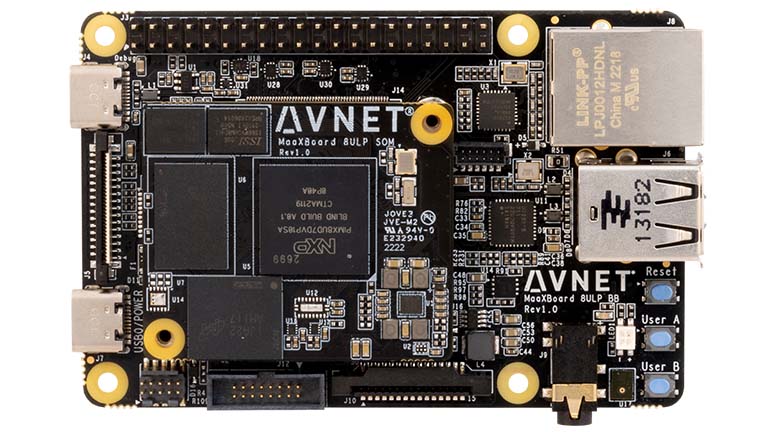
MaaXBoard 8ULP is engineered as two PCBs, a small SOM (43mm x 36mm) connected via 2×100-pin connectors to a baseboard (BB) in compact Raspberry Pi form-factor, which supports a versatile set of I/O interfaces. These include 10/100 Ethernet (with IEEE1588 support), two USB 2.0 host interfaces and a USB 2.0 device interface, MIPI DSI display and MIPI CSI camera interfaces, a Pi-HAT compatible 40-pin header, MikroE Click 16-pin header plus ADC/DAC 6-pin header.
Audio applications are supported via onboard audio codec, digital microphone and stereo headphone jack I/O. Power is sourced via a USB-C connector and is managed via NXP’s PCA9460B PMIC on the SOM plus three additional voltage regulators.
A unique aspect of this board is it’s debug subsystem which supports remote USB access to three UARTs, 16bit I/O expander-based remote control and monitoring, plus integrated SWD/JTAG (or external header) debugger interface.
The back of the board has an M.2 module connector for easy addition of 801.11ac Wi-Fi and Bluetooth 5.1 wireless connectivity.
MaaXBoard
The MaaXBoard is a low-cost, NXP i.MX 8M processor-based, single board computer ideal for embedded computing and smart edge IoT applications. The i.MX 8M family of application processors are based on the Arm® Cortex®-A53 and Cortex-M4 cores which provide industry-leading audio, voice, and video processing for applications that scale from consumer home audio to industrial building automation and embedded computers. The MaaXBoard is production ready, FCC, CE, and RoHS certified. It is available in quantities from one to thousands.
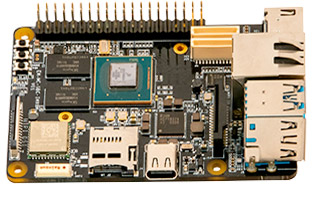
The MaaXBoard contains everything necessary to support and create a Linux, Android, Windows 10 IoT Core, or other OS based system. The platform offers several on-board peripherals including 2 GB of DDR4 memory, a Gigabit Ethernet port, dual USB 3.0 host ports, HDMI output, MIPI-DSI, MIPI-CSI, WiFi, Bluetooth Low Energy, and MicroSD card slot. A Raspberry Pi hat compatible expansion connector also provides interfaces for UART, SPI, I2C, and GPIO. These combined capabilities make it an ideal platform for investigating AI, IOT, and multimedia applications.
Each MaaXBoard is shipped with a custom passive Heatsink and Quick Start guide to assist developers with getting started on their hardware or software development project. A user supplied 5V/3A USB Type C power supply is required to power the board. A 16 GB microSD card and a HDMI cable is recommended for booting the MaaXBoard and connecting it to a LCD monitor. To jump start your development, Avnet offers supported Android 9.0 and Yocto images available for download. For software debugging, an optional Microchip USB-to-UART evaluation board is recommended, allowing USB terminal access through a UART port on the 40-pin expansion connector.
MaaXBoard Mini
The MaaXBoard Mini is a low-cost, NXP i.MX 8M Mini processor-based, single-board computer ideal for embedded computing and smart edge IoT applications. The i.MX 8M Mini family of application processors are based on the Arm® Cortex®-A53 and Cortex-M4 cores, which provide industry-leading audio, voice and video processing for applications that scale from consumer home audio to industrial building automation and embedded computers. The MaaXBoard Mini is production ready, FCC, CE and RoHS certified. It is available in quantities from one to thousands.
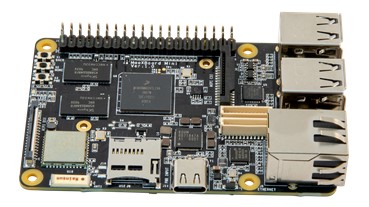
The MaaXBoard Mini contains everything necessary to support and create Linux, Android or other OS-based systems. The platform offers several onboard peripherals including 2GB of DDR4 memory, a gigabit Ethernet port, quad USB 2.0 host ports, MIPI-DSI, MIPI-CSI, WiFi, Bluetooth low energy and a MicroSD card slot. A Raspberry Pi HAT compatible expansion connector also provides interfaces for UART, SPI, I2C and GPIO. These combined capabilities make it an ideal platform for investigating AI, IoT, Industrial and multimedia applications.
Each MaaXBoard Mini is shipped with a passive heatsink and Quick Start guide to assist developers with getting started on their hardware or software development project. A user-supplied 5V/3A USB Type C power supply is required to power the board. A 16GB microSD card and a USB-to-UART serial debugger is recommended for booting the MaaXBoard Mini out-of-box experience. To jump-start your development, Avnet offers supported Android 9.0 and Yocto images available for download. For software debugging, an optional Microchip USB-to-UART evaluation board is recommended, allowing USB terminal access through a UART port on the 40-pin expansion connector.
MaaXBoard Nano
The MaaXBoard Nano is a low-cost, NXP i.MX 8M Nano processor-based, single board computer ideal for embedded computing and smart edge IoT applications. The i.MX 8M Nano family of application processors is based on the Arm® Cortex®-A53 and Cortex-M7 cores which provide industry-leading audio, voice and video processing for applications that scale from consumer home audio to industrial building automation and embedded computers. The MaaXBoard Nano is production ready, FCC, CE and RoHS certified. It is available in quantities of five hundred or greater.
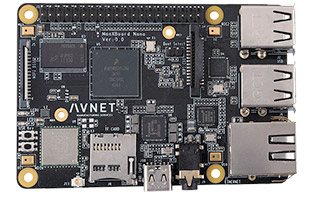
The MaaXBoard Nano contains everything necessary to support and create a Linux, Android or other OS-based systems. The platform offers several on-board peripherals including 1 GB of DDR4 memory, a Gigabit Ethernet port, quad USB 2.0 host ports, MIPI-DSI, MIPI-CSI, WiFi, Bluetooth, MicroSD card slot, four on-board microphones and an audio jack. A Raspberry Pi hat-compatible expansion connector also provides interfaces for UART, SPI, I2C and GPIO. These combined capabilities make it an ideal platform for investigating AI, IOT and multimedia applications.
Each MaaXBoard Nano is shipped with a quick start guide to assist developers with their hardware or software development project. A user-supplied 5V/3A USB Type C power supply is required to power the board. A 16 GB microSD card and a UART USB Serial translator are recommended for booting the MaaXBoard Nano out-of-box experience. To jump-start your development, Avnet offers supported Android 9.0 and Linux images available for download. For software debugging, an optional Microchip USB-to-UART evaluation board is recommended, allowing USB terminal access through a UART port on the 40-pin expansion connector.
MaaXBoard OSM93
MaaXBoard OSM93 features an NXP i.MX 93 System on Chip compute module, with integrated AI/ML NPU accelerator, EdgeLock security enclave and Energy Flex architecture that supports separated processing domains, such as the Application domain with two Arm® Cortex®-A55 (1.7 GHz) cores, the real time domain with Arm® Cortex®-M33 (250 MHz) core and Flex domain with Arm® Ethos-U65 NPU (1 GHz). Other resources on the fitted MSC OSM-SF-IMX93 solder-down module include eMMC (16GB) memory, LPDDR4 (2GB, 3.7 GT/s) with inline ECC support, RTC clock and NXP PCA9451 PMIC.

The Raspberry Pi form-factor carrier SBC carrier board adds QSPI flash memory (16Mbit) plus connectivity and UI interfaces. High speed interfaces include four USB 2.0 interfaces (2x host type A, 1x host type-C, 1x device type-C), MIPI DSI display and MIPI CSI camera interfaces, two 1 Gbps Ethernet ports and two high-speed CAN interfaces. Expansion interfaces include a Pi-Hat 40pin-header, 6-pin ADC header and 6-pin SAI digital audio header (supplemented by two onboard PDM microphones). Level-shifted debug UARTs are pinned-out for the application and RT cores.
An M.2 key-E connector on back of the board facilitates easy integration of optional NXP based tri-radio M.2 module solutions, for concurrent Wi-Fi 6, Bluetooth (5.3) and 802.15.4 wireless operation.
MaaXBoard RT
MaaXBoard RT is a dual-purpose SBC board based on NXP’s i.MX RT1176 processor. Optimized for use as low-cost development board and to embed in OEM products, it provides advanced security, high-performance low-latency real-time operation, with a versatile set of peripheral interfaces ideal for implementation of eg. industrial automation and power-efficient audio/visual AI-enabled applications. i.MX RT1170 series cross-over processors are based on Arm ® Cortex ®-M7 and Cortex-M4 cores for real-time industrial performance and microcontroller usability at a cost-effective price.
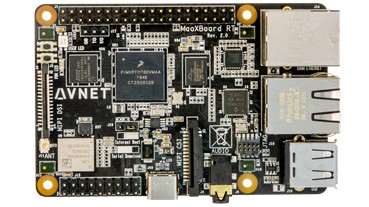
Software enablement includes a comprehensive NXP RT1170 SDK that accelerates application development with drivers, middleware, code snippets and FreeRTOS based examples (AzureRTOS support will follow soon). Out-of-box Avnet example reference designs are also provided to jump-start development.
Hardware components include SDRAM and HyperFlash high-speed 256 Mb memories, two Ethernet ports, USB 2.0 host and device ports, MIPI-DSI display interface and MIPI-CSI camera interface, Wi-Fi 5 and Bluetooth 5.1 wireless, an audio subsystem that supports Bluetooth PCM audio, onboard PDM microphones (4) plus amplified stereo audio jack output. Expansion 40 pin (Pi HAT-compatible) and 20 pin headers pin-out peripheral interfaces such as UART, SPI, I2C, CAN bus and GPIO for further system expansion, making this versatile platform ideal for prototyping and deployment of realtime AI and industrial applications.
MaaXBoard RT also has advanced security features to protect your application. (eg. Crypto engine, key protection, random number generation, secure storage, bus encryption, tamper protection, secure boot and more) to secure mission critical applications (eg. electrical grid control and medical applications) MaaXBoard RT ships with a quick start guide to ensure that hardware and software application development can commence efficiently. The user is responsible for providing an SWD/JTAG debug probe (inexpensive NXP MCU-LINK or equivalent) as well as a suitable 5V/3A USB power adapter with USB-C connector.